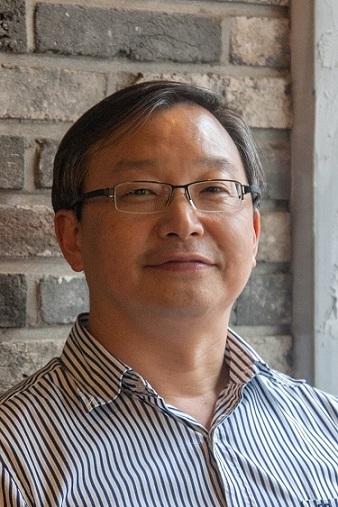[Herald Interview] Former Samsung engineer develops translation solution to break down language barrier
Local translation solution developer aims to take on Google and Apple
By Kim Young-wonPublished : May 25, 2016 - 11:26
Living in a world without language barriers is not a far-fetched idea at all thanks to technological advancement, according to a big data expert in linguistic analysis.
“It would be fair to say that translation technology for written language is now fully mature, and translation solutions for written language -- not for spoken language though -- are widely deployed in both the public and private sectors,” said Lea Jong-ho, chief technology officer of Seoul-headquartered translation and interpretation solution developer SYSTRAN International.
Lea was previously a senior software engineer for Samsung Electronics.
“It would be fair to say that translation technology for written language is now fully mature, and translation solutions for written language -- not for spoken language though -- are widely deployed in both the public and private sectors,” said Lea Jong-ho, chief technology officer of Seoul-headquartered translation and interpretation solution developer SYSTRAN International.
Lea was previously a senior software engineer for Samsung Electronics.

The technological advances, including bid data and machine learning, are being widely utilized for mobile and computer devices to pick up and understand human languages, allowing people to communicate in different languages in an easy manner.
Computer software firm Adobe was able to save time and cost by translating the manuals of its IT services and products from English to Russian with the SYSTRAN software.
Korea’s 18 local governments also use SYSTRAN’s solutions to translate their websites, and mobile applications.
The SYSTRAN programs can translate a total of 138 languages at the moment and new languages will be added to the list down the road. Founded in 1968, the company runs three global offices in San Diego, Paris and Luxemburg.
“With my past experience at Samsung where I led joint projects with global research and development labs, I hope I can bring SYSTRAN’s products and solutions to more global markets,” CTO Lea said.
One of his projects at Samsung includes developing a smart TV solution that recommends TV programs tailored for individual users in nearly 40 nations.
The software, which Lea and his team had developed at Samsung, is aimed at gathering and analyzing the data of TV programs and consumers’ viewing patterns in each nation.
Analyzing buzzwords on social networking services and the Web to provide the best recommendations for individuals was one of his important tasks, which is somehow in line with his work at SYSTRAN, according to the CTO.
SYSTRAN’s translation solutions have been deployed for tech heavyweights, such as Samsung, Google, as well as Korean local governments and organizations.
The company has supplied its translation program for Samsung’s Galaxy smartphones since 2013.
The Seoul-based firm is now working on developing different types of translation solutions, including embedded software and an open translation platform available online, and those for voice recognition and optical character recognition.
He refused to talk about the future partnership with Samsung, but said the company will try to strengthen its ties with new translation solutions for mobile devices.
Earlier this year, SYSTRAN joined hands with local optical equipment firm Green Optics to roll out a Google Glass-like translator, which display translations between Korean and English on the glasses.
The CTO said the translation glasses were experimental and needed some improvement, especially in terms of user experience.
“While using the glasses, users can get easily tired and feel dizzy since they have to watch, back and forth, the objects around them and the translated texts appearing right in front of their eyes,” the CTO said.
Augmented reality glasses Google Glass also failed to hit the mass market due to the same issue, the former Samsung engineer said.
CTO Lea forecast wearables fitted with translation solutions will soon join the mainstream market.
“Contact lenses that work like Google Glass are more user friendly and have more possibility to be well embraced by consumers, only if they overcome one issue, dry eye syndrome, a common condition found among contact lens wearers,” he said.
Seeing a big potential in the translation tech sector, tech heavyweights around the world, including Google and Apple, have been pouring massive resources to master human languages and roll out services like Google Translate and Apple’s Siri, which can serve as a personal assistant/translator for individuals.
SYSTRAN’s translation solutions have an upper hand over those of the global giants, especially, in reflecting the fast changes in languages, according to the SYSTRAN CTO.
“The translation solutions can absorb and accurately use up-to-date languages and slangs often used by the young generation at a faster pace than competing software like Google’s and Apple’s,” the CTO said.
Google has been smartening up its translation solution with neural network technology, which works like a biological neural network, improving the accuracy of translation and increasing the number of languages it can translate -- currently around 100.
Microsoft’s video chat application Skype translates the speeches of users and text conversations in real time.
Referring to some languages used in megahit Korean drama “Descendants of the Sun,” he said “Mal imnida, an often-used phrase in the drama, can be translated into ‘this is a horse,” if a translation solution does not accurately reflect the usage of terms and current linguistic trends.”
The Korean phrase “mal imnida,” comes at the end of an explanatory sentence -- meaning “that is,” or “I mean.”
By Kim Young-won (wone0102@heraldcorp.com)








![[Hello India] Hyundai Motor vows to boost 'clean mobility' in India](http://res.heraldm.com/phpwas/restmb_idxmake.php?idx=644&simg=/content/image/2024/04/25/20240425050672_0.jpg&u=)









